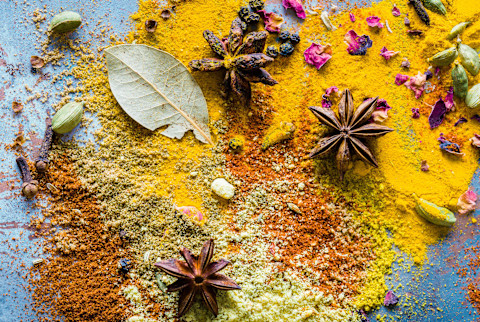5 Ways RDs Love To Use Turmeric For Its Anti-Inflammatory Benefits

When it comes to incorporating herbs and spices into our diet, there's one that consistently sticks out as a powerhouse plant. It's none other than turmeric, an antioxidant-rich ingredient that's been used for thousands of years to promote well-being.
Turmeric contains a variety of curcuminoids, which are bioactive compounds that help deliver these impressive benefits. And its main curcuminoid—curcumin—has been extensively studied1 for its anti-inflammatory actions, antioxidant activity, and ability to reduce oxidative damage2.
Many people find that working turmeric into their daily routine helps to ease muscle pain and joint discomfort driven by inflammation, boost gut health, and improve mood.
Looking for some inspiration on how to seamlessly work this spice into your cooking? Here are five ways registered dietitians use it in their own kitchens:
In a Tobagonian curry
"Personally, I love seafood; in fact, it's my favorite food. I love curry crab and dumplings from Tobago, the sister island of Trinidad. Tobagonian curry is a combination of turmeric, geera, coriander, black pepper, and garlic—sometimes even more. These spices have incredible antioxidant properties and impart a wonderful bite."
—Maya Feller, M.S., R.D., CDN, registered dietitian nutritionist of Brooklyn-based Maya Feller Nutrition
In a bhindi masala
"My all-time favorite cultural dish since I was young is called bhindi masala, which is a South Asian spiced okra dish. The okra is sautéed with a blend of spices like turmeric, chili powder, cumin, and dried mango powder, which brings a burst of flavor in every bite. This dish has been a weekly staple since it can be an enjoyable way to incorporate plant-forward meals and celebrate cultural flavors in my household."
—Huma Naz, R.D., clinical dietitian in Chicago, Illinois
In an eggplant curry
"One of my favorite cultural dishes is eggplant curry. This flavorful dish is loaded with spices, like turmeric and garlic, that offer beneficial antioxidants and are great for gut health. It's also a great way to work in a plant-based dish that's satisfying in both taste and texture!"
—Jessica Keene, M.S., R.D., SNS, school R.D. and regional field manager of the San Diego Unified School District, San Diego, California
In Middle Eastern cuisine
"Personally, I love Middle Eastern cuisine, especially Lebanese, Persian, and Turkish. They incorporate an abundance of flavorful spices like saffron, sumac, and turmeric—loaded with an array of antioxidants plus fiber-rich, nutrient-dense vegetables, dried fruit, legumes, whole grains, nuts, and seeds. If you are vegan or plant-based, it's easy to find several menu options that are both delicious and nutritious when you dine out. So it's a no-brainer for me because my delicate GI system works best on a high-fiber diet."
—Jennifer Hnat, RDN, mindful and intentional eating expert
As an everyday staple
"As a longevity dietitian, I help my clients to optimize their metabolism with a diet that includes a lot of herbs and spices. My favorite herbs to use are rosemary, oregano, thyme, cilantro, and parsley. Additional flavors from spices like ginger, turmeric, and pepper contain powerful anti-inflammatory compounds that are beneficial for digestion as well."
—Ella Davar, R.D., CDN, integrative dietitian, health coach, speaker, and author
The takeaway
Whether you whip up some eggplant curry or add some turmeric to your next salad dressing, this spice is one you don't want to miss out on.
Clearly, there's no shortage of ways to incorporate turmeric into your diet—not to mention, you can also take it as a supplement to ensure that you're reaping its benefits on a daily basis.
